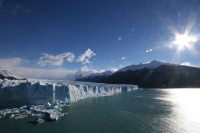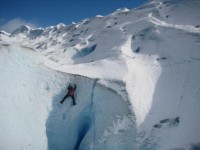Thu 24 Apr 2008
Ice, Ice Baby
Posted by Derek under Argentina
[2] Comments

After a 6 hour bus ride in the snow across the border with Chile, we arrived in El Calafate, Argentina. Until a few years ago, El Calafate had a population of less than 5,000 but has undergone a massive boom due to tourism, dramatically increasing the town’s population. The primary, and perhaps sole, reason for this increase is El Calafate’s close proximity to Parque Nacional Los Glaciares, a large national park hosting several glaciers including the magnificent Perito Moreno Glacier.

We stayed at a popular hostel located on top of a large hill outside of El Calafate that provides a dramatic view of the sunset over the area’s lakes and mountains. We spent our first day in El Calafate lazing around the town and visiting some of its numerous shops and restaurants. (One of the lessons we’ve learned about long-term travel during our time on the road is that building a day of rest into our schedules after a few days in a row of seeing the sights really helps us to appreciate all of the amazing things we’re encountering. Without a break once in awhile, it all starts to run together.) The next day we signed up for a mini-trekking glacier tour.

We arrived at the Perito Moreno Glacier after an hour and a half bus ride from El Calafate. The glacier is renowned for its massive size (around 150 feet high, 2 or 3 miles wide and over 20 miles long!), its beauty, its state of equilibrium ((As world temperatures have risen in recent years, most glaciers are receding. The Perito Moreno Glacier is one of the few glaciers that is in equilibrium. On an approximately 4 year cycle, the glacier recedes for a couple of years and then advances the next two.))and – most importantly – its easy access. We’ve seen a few other glaciers in the previous two weeks, but these viewings required long hikes or rather expensive boat rides in remote areas. To view the Perito Moreno Glacier, you simply need to board a bus.

After our arrival and a short, but choppy, boat ride across a lake, we were quickly strapping crampons to our shoes (after our volcano-climbing experience, we’ve become quite adept at using crampons). Led by two guides (one of which showed off by climbing up one of the ice walls), we hiked on the glacier, carefully dodging crevasses and unstable ice.
The remainder of our time in the park was spent viewing the glacier, listening to the cracking of the ice and being fortunate enough to see huge chunks of the glacier come crashing down into the adjacent lake on their way to becoming blue icebergs (Science lesson of the day: Glacial ice looks blue due to its extreme density – the ice is packed so hard that it absorbs every other color of the spectrum except blue – so blue is what you see!). From the viewing platforms on a clear day (which we had), you can literally see miles of the glacier in front of you – surely one of the most dramatic sites on the planet.
[embedplusvideo height=”350″ width=”450″ editlink=”http://bit.ly/1mFHfL7″ standard=”http://www.youtube.com/v/Rz8vf74UqI8?fs=1″ vars=”ytid=Rz8vf74UqI8&width=450&height=350&start=&stop=&rs=w&hd=0&autoplay=0&react=1&chapters=¬es=” id=”ep9075″ /]
Of all the places you have been thus far, this is the first place that has “spoken” to me so directly. The pictures are simply stunning as are the landscapes they reflect—I am sure you have pinched yourselves frequently in the last few days as you stood in breathless gaze at the sheer wonder of it all. This is a trip I will take one day—WOW. Thanks for once again inviting on on your journey.
Matt Lauer of the TODAY show just showed many of the same things to do—he is in Argentina today—very cool.